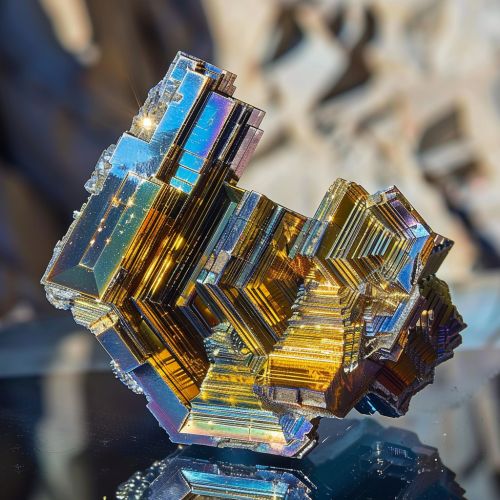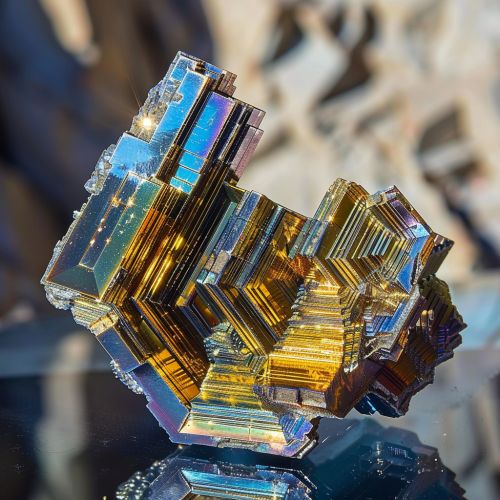Topological phases
Introduction
Topological phases are states of matter that extend beyond the traditional classification of phases based on symmetry breaking and local order parameters. These phases are characterized by global properties of the system's wavefunctions and are robust against perturbations. The study of topological phases has become a significant area of research in condensed matter physics, leading to the discovery of new materials and phenomena with potential applications in quantum computing and other advanced technologies.
Historical Background
The concept of topological phases emerged from the study of the quantum Hall effect in the 1980s. The integer quantum Hall effect, discovered by Klaus von Klitzing, revealed that the Hall conductance is quantized in integer multiples of a fundamental constant. This quantization was later understood to be a consequence of the topological properties of the electronic wavefunctions in a two-dimensional electron gas subjected to a strong magnetic field.
The theoretical framework for understanding these phenomena was developed by David J. Thouless and collaborators, who introduced the concept of topological invariants, such as the Chern number, to classify different quantum Hall states. This work laid the foundation for the broader study of topological phases.
Topological Insulators
Topological insulators are materials that are insulating in their bulk but have conducting states on their surfaces or edges. These surface states are protected by time-reversal symmetry and are robust against non-magnetic impurities. The discovery of topological insulators in the late 2000s opened a new frontier in the study of topological phases.
Theoretical Framework
The theoretical description of topological insulators involves the concept of band theory and the Berry phase. In a topological insulator, the electronic band structure exhibits a non-trivial topology, characterized by a topological invariant known as the Z2 invariant. This invariant distinguishes topological insulators from ordinary insulators.
Experimental Realizations
Topological insulators have been experimentally realized in various materials, including bismuth selenide (Bi2Se3) and bismuth telluride (Bi2Te3). These materials exhibit surface states that can be probed using techniques such as angle-resolved photoemission spectroscopy (ARPES) and scanning tunneling microscopy (STM).


Topological Superconductors
Topological superconductors are superconducting materials that host Majorana fermions, which are particles that are their own antiparticles. These exotic quasiparticles are of great interest for quantum computing due to their potential use in fault-tolerant topological quantum computation.
Theoretical Framework
The theoretical description of topological superconductors involves the concept of p-wave pairing and the Bogoliubov-de Gennes equation. In a topological superconductor, the superconducting order parameter has a non-trivial topology, leading to the emergence of Majorana bound states at the edges or vortices of the superconductor.
Experimental Realizations
Experimental realizations of topological superconductors include proximity effect systems, where a conventional superconductor is placed in contact with a topological insulator or a semiconductor with strong spin-orbit coupling. Signatures of Majorana fermions have been observed in these systems using techniques such as tunneling spectroscopy.
Topological Semimetals
Topological semimetals are materials where the conduction and valence bands touch at discrete points or along lines in the Brillouin zone. These materials exhibit unique electronic properties, such as high mobility and unusual magnetotransport phenomena.
Weyl and Dirac Semimetals
Weyl semimetals and Dirac semimetals are two classes of topological semimetals. In Weyl semimetals, the band touching points, known as Weyl nodes, act as monopoles of Berry curvature. Dirac semimetals, on the other hand, have Dirac points where four bands touch, and these points can be viewed as a superposition of two Weyl nodes with opposite chirality.
Experimental Realizations
Materials such as tantalum arsenide (TaAs) and cadmium arsenide (Cd3As2) have been identified as Weyl and Dirac semimetals, respectively. These materials exhibit characteristic features such as the Fermi arc surface states and unusual magnetoresistance.
Topological Crystalline Insulators
Topological crystalline insulators are materials where the topological properties are protected by crystal symmetries rather than time-reversal symmetry. These materials exhibit surface states that are robust against perturbations that preserve the crystal symmetry.
Theoretical Framework
The theoretical description of topological crystalline insulators involves the concept of crystal symmetry and the mirror Chern number. In these materials, the electronic band structure has a non-trivial topology protected by symmetries such as mirror symmetry.
Experimental Realizations
Topological crystalline insulators have been experimentally realized in materials such as tin telluride (SnTe). These materials exhibit surface states that can be probed using techniques such as ARPES and STM.
Topological Order and Anyons
Topological order is a type of order in quantum states of matter that goes beyond the conventional symmetry-breaking description. It is characterized by ground state degeneracy and the presence of anyons, which are quasiparticles with fractional statistics.
Theoretical Framework
The theoretical description of topological order involves the concept of quantum entanglement and topological quantum field theory (TQFT). In systems with topological order, the ground state degeneracy depends on the topology of the underlying space, and anyons can exhibit non-Abelian statistics.
Experimental Realizations
Experimental realizations of topological order include the fractional quantum Hall effect (FQHE) and certain spin liquid states. These systems exhibit exotic properties such as fractional charge and long-range entanglement.
Applications and Future Directions
The study of topological phases has led to numerous potential applications, particularly in the field of quantum computing. Topological qubits, based on Majorana fermions, offer a promising route to fault-tolerant quantum computation. Additionally, topological materials are being explored for applications in spintronics, photonics, and other advanced technologies.
Quantum Computing
Topological qubits are a type of qubit that are protected from local sources of decoherence by the topological properties of the system. This makes them highly attractive for building robust quantum computers. Research is ongoing to develop practical implementations of topological qubits using materials such as topological superconductors and quantum Hall systems.
Spintronics
Topological materials, such as topological insulators and Weyl semimetals, exhibit strong spin-orbit coupling and spin-momentum locking. These properties can be harnessed for spintronic devices, which use the spin of electrons for information processing and storage.
Photonics
Topological photonics is an emerging field that explores the use of topological concepts in photonic systems. Topological photonic crystals and metamaterials can exhibit robust edge states for light, which could lead to new types of optical devices with enhanced performance and stability.
